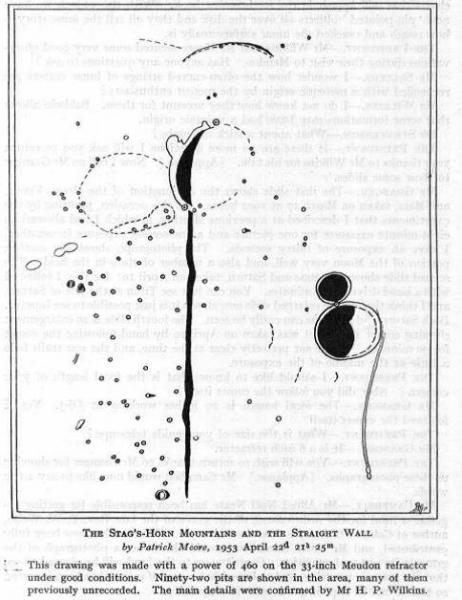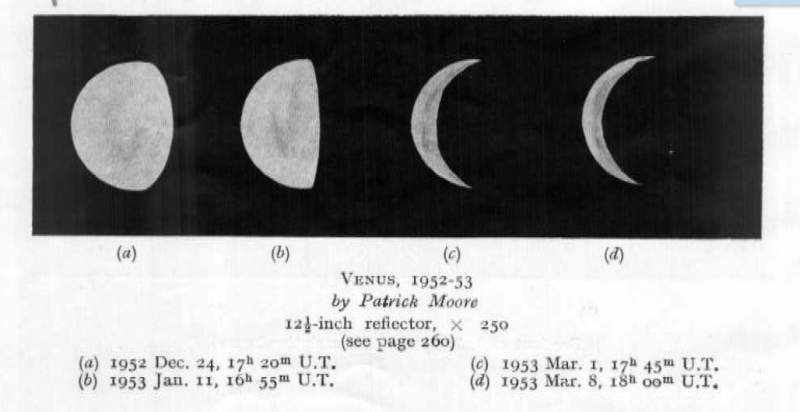2014 June 7
From the Archives
 This is the first of a regular series of articles looking back through the BAA’s extensive archive. We begin with an item by the BAA’s most famous member, Sir Patrick Moore, who joined the BAA at the age of 11, eighty years ago this year.
This is the first of a regular series of articles looking back through the BAA’s extensive archive. We begin with an item by the BAA’s most famous member, Sir Patrick Moore, who joined the BAA at the age of 11, eighty years ago this year.
The BAA’s archives contain a wealth of historical detail extending over the past 125 years. From the outset, the BAA has published a Journal, now bimonthly, the first appearing in October 1890. These have now been digitised and indexed, and can be purchased online by clicking here. Over coming years, we hope to tackle the much larger task of digitising the vast archive of historical observations held by the BAA, which we hope eventually to make available to members and others for their personal observational or research interests.
As the article below demonstrates, Patrick Moore was not just a prolific broadcaster and superb writer, but also a highly skilled observer. His name appears time and again through the pages of the Journal. The extract below is taken from the Journal of 1953 July – some 61 years ago – when Patrick was in his late twenties.
The image to the right is a drawing he made of the Moon in the same year.
John Chuter, Archivist
|
Recent Observations of Venus By Patrick Moore, F.R.A.S.
Drawings have recently been published showing hard, definite markings on the surface of the planet, similar to those depicted many years ago by Lowell. In my opinion, these markings have no real existence. Many of the recent drawings indicate a darkish central area and spoke-like streaks extending in all directions from it—a clear case of optical defects or tricks of the eye. I must make it quite clear that I am by no means decrying the observers concerned; far from it—but it is significant that they have invariably used small telescopes, and I merely suggest that they are not correct in their interpretations. It is often said that ‘the smaller the telescope, the clearer the markings of Venus’. I find it extremely hard to believe that a 3-inch refractor will, under any conditions, show more than a comparatively large instrument; and in any case, the statement is certainly wrong with regard to Venus. On 1953 March 1 conditions were excellent; I drew Venus first with my 3-inch refractor, and then with my 12 1/2-inch reflector. Two undeniable diffuse shadings were seen, but although they were barely glimpsed with the refractor they were obvious with the reflector; the drawing made is reproduced in Plate XIV— though it is not easy to depict the shadings as diffuse and vague as they are in reality. I have made similar experiments on a number of occasions, and the real markings of Venus—the hazy shadings and occasional bright patches—are best seen with a large aperture. It is only the false linear features which require a small telescope! I am not the first observer who has tried to deduce a rotation period from studying the shadings of Venus, and undoubtedly I shall not be the last; but I am not ashamed to admit defeat, as the problem has beaten countless numbers of observers more skilful than I. In fact, the rotation period puzzle is probably insoluble by visual means alone. The generally accepted value is around a month, and the shadings are not permanent enough to yield a reliable value; they shift and alter from night to night, although I have never been able to detect any alteration in the course of a single evening’s (or morning’s) work. One interesting fact I have noted is that there is often a V-shaped appearance on the western side of Venus. It alters from night to night, and is frequently absent altogether; in fact, it gives every indication of being due to drifting cloud. However, I have seen it during the past five evening elongations, and two recent drawings of it are given here. As a matter of fact, it was not so prominent during the last elongation as it was in 1951. Up to 1952 December 6 I had not seen it since the beginning of November. It was clear on December 15, but could not be traced on December 21 (though there was some sort of nebulous marking in the area). It was seen again on December 24, rather altered in aspect, and for the last time on 1953 January 11. Bright areas can be made out from time to time. Frequently the cusps appear bright, and just occasionally the bright areas seem to be bordered by a dark ‘collar ’. This was so on 1953 March 8, as is shown. Personally, I never see the cusp areas at all ‘brilliant’ or ‘ dazzling ’, as other observers seem to do, and I am not sure quite how much can be ascribed to optical effects. It is interesting to speculate whether the cusps do, in fact, mark the poles of Venus; as we do not know the precise axial inclination, this may not be the case. In any event, the theory that the bright areas (when seen) are due to snow is palpably wrong. The terminator of Venus presents some features of interest. It is not always a regular curve (see the March 1 drawing), and now and then unmistakable deformations can be seen. One such deformation has been noted this year; a marked indentation, some way from the southern cusp, was followed from March 4 to March 11 (see the March 8 drawing). This has also been seen by others, and I noted it at the corresponding phase in 1949, so that it seems to be real enough. If the poles are more or less coincident with the cusps, it is possible that this persistent deformation is due to a long, low-lying area, just as it is possible that the ‘V-formation’ is due to some topographical peculiarity; but once again I feel inclined to be wary. The eye can play strange tricks. A slightly less brilliant part of the terminator might well appear depressed if surrounded by brighter areas, even if it was not actually so. Browns, greens and reds have been recorded on Venus by some observers. I can only comment that they escape me completely. Up to this last elongation, I had never been able to see the famous Ashen Light of Venus. However, I recorded it distinctly on March 16 (18h), March 22 (18.40), March 24 (19.20) and March 27 (19.30) of this year, the entire disk being faintly seen on the three latter dates. I can hardly agree with the old suggestion made by Gruithuisen that it was due to artificial lights on the planet—a sort of Cytherean Coronation, perhaps!—but neither do I think that it was due to a trick of the light, though I am open to conviction. I am hoping that other observers will have records of the planet at those times; if so, and they missed the Light, I am obviously wrong, and must put my record of it down to illusion. On March 23, at 18.40, the Light was absent, despite good seeing. My efforts to combine my observations into a chart of the Cytherean surface have met with no success, but this was only to be expected; the shadings are undoubtedly atmospheric. One or two patches, however (principally those making up the V), have persisted in recognizable form for some evenings running, and from watching the drift in these, and from the fact that there is never any perceptible alteration in appearance except after intervals of something like a day, a fairly slow rotation seems indicated. So far as my observations may be said to confirm anything at all, they are in good accord with the generally accepted period of about a month. I hope that this paper may persuade other observers to pay some attention to Venus, most beautiful of all the celestial bodies and certainly one of the most puzzling. |
| The British Astronomical Association supports amateur astronomers around the UK and the rest of the world. Find out more about the BAA or join us. |

 It is some years now since a paper dealing with observations of Venus was presented to the B.A.A., and a brief discussion of some of my recent results may, therefore, be of interest. I have observed the planet whenever possible during the last eight years, the telescopes used being a 6-inch refractor (until 1949), an 8 1/2-inch reflector (until 1951), and latterly a 12 1/2-inch reflector, as well as frequent observations with a good 3-inch refractor. Although confined mainly to the most recent elongation, the statements in the present paper are derived from my whole series of Venus observations.
It is some years now since a paper dealing with observations of Venus was presented to the B.A.A., and a brief discussion of some of my recent results may, therefore, be of interest. I have observed the planet whenever possible during the last eight years, the telescopes used being a 6-inch refractor (until 1949), an 8 1/2-inch reflector (until 1951), and latterly a 12 1/2-inch reflector, as well as frequent observations with a good 3-inch refractor. Although confined mainly to the most recent elongation, the statements in the present paper are derived from my whole series of Venus observations.